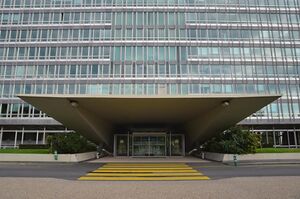Gentu Heritage & Culture Remembrance Organisation
This article is a work in progress. Any information here may not be final as changes are often made to make way for improvements or expansion of lore-wise information about Gentu. Please comment on this article's talk page to share your input, comments and questions. Note: To contribute to this article, contact User:Philimania. |
 | |
 GEKSO's headquarters in Moreux, Cavala. | |
| Abbreviation | GEKSO |
|---|---|
| Formation | 3 Hunyo 1910 |
| Legal status | Active |
| Headquarters | Moreux, Cavala |
Head | Director-General XXX |
| Website | gekso.org |
The Gentu Heritage & Culture Remembrance Organisation, (Neragese: Gentu Erbe & Kulture Souvenir Organisation; Cavalan: Organisation du souvenir du patrimoine et de la culture de Gentu; GEKSO) is an organisation aimed at promoting world peace and security through international cooperation in education, arts and culture. As of 1998, it has XXX member states as well as partners in the non-governmental, intergovernmental and private sector. It has its headquarters in Moreux, Cavala.
GEKSO was founded in 1910. Its constitution establishes the agency's goals, governing structure, and operating framework. GEKSO's founding mission, which was shaped by the Naphtoran Wars, is to advance peace, sustainable development and human rights by facilitating collaboration and dialogue among nations. It pursues this objective through 4 major programme areas: education, natural science, culture and communication/information. GEKSO sponsors projects that improve literacy, provide technical training and education, protect independent media and press freedom, preserve regional and cultural history, and promote cultural diversity.
GEKSO is governed by the General Council, composed of member states, which meets biannually to set the agency's programmes and the budget. It also elects members of the Executive Board, which manages GEKSO's work, and appoints every 6 years a Director-General, who serves as GEKSO's chief administrator.
History
Creation
After the end of the Naphtoran Wars with the conclusion of the Second Calidum War in 1905, the necessity for an international organization that viewed the presevation of education and culture as vital elements of human history was expressed in the Greywall Conference, agreed upon by Neragon, Cavala, Paloa and many others. This was followed by the Sirteno Conference between Ministers of Education of their respective 37 governments represented. Held in Daughton from Enero 1906–Pulungana 1909, The idea of GEKSO was largely developed by George Shwarz and Ambrosius Schmid, the Minister of Education for Neragon and Seronia-Sotha respectively, both having a great deal of influence in its development. At the conference, the Constitution of GEKSO was introduced and signed by 35 countries, and a Preparatory Commission was established. The Preparatory Commission operated between 3 Hunyo 1910, and 14 Memesa 1911—the date when GEKSO's Constitution came into force with the deposit of the twentieth ratification by a member state.
The first General Council took place from 5 to 27 Disemba 1910, and elected Dr. John Bogen to Director-General. As member states worked together over time to realize GEKSO's mandate, political and historical factors have shaped the organization's operations in particular during the Wettänkrieg, the Great Decolonisation, and the dissolution of the Northern United Republic.
Development and contemporary period
TBA
Structure
Director-General
TBA
General Council
TBA
Activities
TBA
Media
TBA
Institutes and centres
The institutes are specialized departments of the organization that support GEKSO's programme, providing specialized support for cluster and national offices.
| Abbr | Name | Neragese translation | Location |
|---|---|---|---|
| USS | International Institute for Statistics | Unternational Schule pour Statistiques | Godfrey |
| GZE | GEKSO Centre of Heritage | GEKSO Zentrum de Erbe | Neo-Odius |
| FOM | Fragenward Academy of Magic | Fragenward Obènschul de Mutamni | Northern Neragon |
| TBA | TBA | TBA | TBA |
Prizes
TBA
International Days observed at GEKSO
TBA
Member states
TBA
GEKSO sites
TBA



